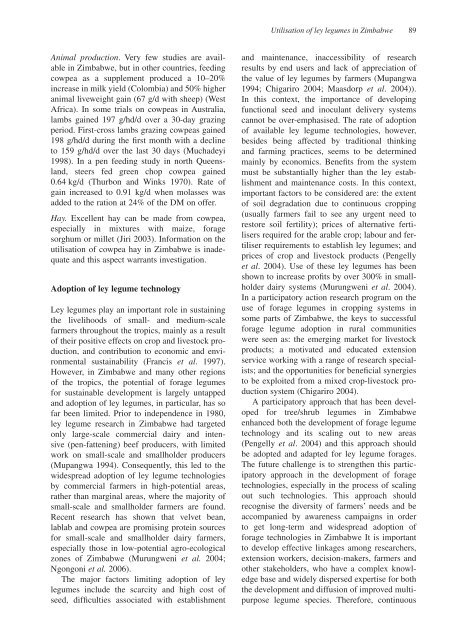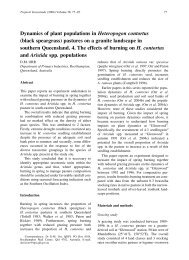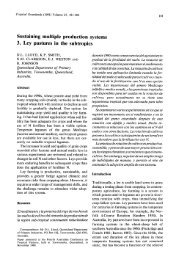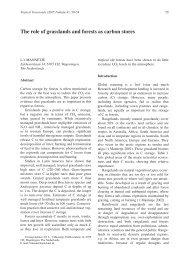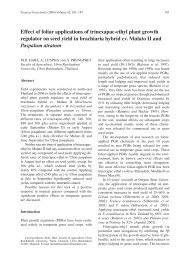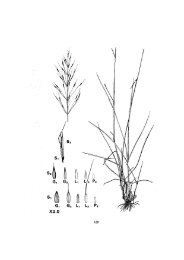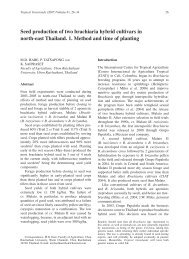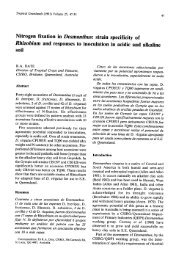Utilisation of ley legumes as livestock feed in Zimbabwe - Tropical ...
Utilisation of ley legumes as livestock feed in Zimbabwe - Tropical ...
Utilisation of ley legumes as livestock feed in Zimbabwe - Tropical ...
Create successful ePaper yourself
Turn your PDF publications into a flip-book with our unique Google optimized e-Paper software.
<strong>Utilisation</strong> <strong>of</strong> <strong>ley</strong> <strong>legumes</strong> <strong>in</strong> <strong>Zimbabwe</strong> 89<br />
Animal production. Very few studies are available<br />
<strong>in</strong> <strong>Zimbabwe</strong>, but <strong>in</strong> other countries, <strong>feed</strong><strong>in</strong>g<br />
cowpea <strong>as</strong> a supplement produced a 10–20%<br />
<strong>in</strong>cre<strong>as</strong>e <strong>in</strong> milk yield (Colombia) and 50% higher<br />
animal liveweight ga<strong>in</strong> (67 g/d with sheep) (West<br />
Africa). In some trials on cowpe<strong>as</strong> <strong>in</strong> Australia,<br />
lambs ga<strong>in</strong>ed 197 g/hd/d over a 30-day graz<strong>in</strong>g<br />
period. First-cross lambs graz<strong>in</strong>g cowpe<strong>as</strong> ga<strong>in</strong>ed<br />
198 g/hd/d dur<strong>in</strong>g the first month with a decl<strong>in</strong>e<br />
to 159 g/hd/d over the l<strong>as</strong>t 30 days (Muchadeyi<br />
1998). In a pen <strong>feed</strong><strong>in</strong>g study <strong>in</strong> north Queensland,<br />
steers fed green chop cowpea ga<strong>in</strong>ed<br />
0.64 kg/d (Thurbon and W<strong>in</strong>ks 1970). Rate <strong>of</strong><br />
ga<strong>in</strong> <strong>in</strong>cre<strong>as</strong>ed to 0.91 kg/d when mol<strong>as</strong>ses w<strong>as</strong><br />
added to the ration at 24% <strong>of</strong> the DM on <strong>of</strong>fer.<br />
Hay. Excellent hay can be made from cowpea,<br />
especially <strong>in</strong> mixtures with maize, forage<br />
sorghum or millet (Jiri 2003). Information on the<br />
utilisation <strong>of</strong> cowpea hay <strong>in</strong> <strong>Zimbabwe</strong> is <strong>in</strong>adequate<br />
and this <strong>as</strong>pect warrants <strong>in</strong>vestigation.<br />
Adoption <strong>of</strong> <strong>ley</strong> legume technology<br />
Ley <strong>legumes</strong> play an important role <strong>in</strong> susta<strong>in</strong><strong>in</strong>g<br />
the livelihoods <strong>of</strong> small- and medium-scale<br />
farmers throughout the tropics, ma<strong>in</strong>ly <strong>as</strong> a result<br />
<strong>of</strong> their positive effects on crop and <strong>livestock</strong> production,<br />
and contribution to economic and environmental<br />
susta<strong>in</strong>ability (Francis et al. 1997).<br />
However, <strong>in</strong> <strong>Zimbabwe</strong> and many other regions<br />
<strong>of</strong> the tropics, the potential <strong>of</strong> forage <strong>legumes</strong><br />
for susta<strong>in</strong>able development is largely untapped<br />
and adoption <strong>of</strong> <strong>ley</strong> <strong>legumes</strong>, <strong>in</strong> par ticular, h<strong>as</strong> so<br />
far been limited. Prior to <strong>in</strong>dependence <strong>in</strong> 1980,<br />
<strong>ley</strong> legume research <strong>in</strong> <strong>Zimbabwe</strong> had targeted<br />
only large-scale commercial dairy and <strong>in</strong>tensive<br />
(pen-fatten<strong>in</strong>g) beef producers, with limited<br />
work on small-scale and smallholder producers<br />
(Mupangwa 1994). Consequently, this led to the<br />
widespread adoption <strong>of</strong> <strong>ley</strong> legume technologies<br />
by commercial farmers <strong>in</strong> high- potential are<strong>as</strong>,<br />
rather than marg<strong>in</strong>al are<strong>as</strong>, where the majority <strong>of</strong><br />
small-scale and smallholder farmers are found.<br />
Recent research h<strong>as</strong> shown that velvet bean,<br />
lablab and cowpea are promis<strong>in</strong>g prote<strong>in</strong> sources<br />
for small-scale and smallholder dairy farmers,<br />
especially those <strong>in</strong> low-potential agro-ecological<br />
zones <strong>of</strong> <strong>Zimbabwe</strong> (Murungweni et al. 2004;<br />
Ngongoni et al. 2006).<br />
The major factors limit<strong>in</strong>g adoption <strong>of</strong> <strong>ley</strong><br />
<strong>legumes</strong> <strong>in</strong>clude the scarcity and high cost <strong>of</strong><br />
seed, difficulties <strong>as</strong>sociated with establishment<br />
and ma<strong>in</strong>tenance, <strong>in</strong>accessibility <strong>of</strong> research<br />
results by end users and lack <strong>of</strong> appreciation <strong>of</strong><br />
the value <strong>of</strong> <strong>ley</strong> <strong>legumes</strong> by farmers (Mupangwa<br />
1994; Chigariro 2004; Ma<strong>as</strong>dorp et al. 2004)).<br />
In this context, the importance <strong>of</strong> develop<strong>in</strong>g<br />
functional seed and <strong>in</strong>oculant delivery systems<br />
cannot be over-emph<strong>as</strong>ised. The rate <strong>of</strong> adoption<br />
<strong>of</strong> available <strong>ley</strong> legume technologies, however,<br />
besides be<strong>in</strong>g affected by traditional th<strong>in</strong>k<strong>in</strong>g<br />
and farm<strong>in</strong>g practices, seems to be determ<strong>in</strong>ed<br />
ma<strong>in</strong>ly by economics. Benefits from the system<br />
must be substantially higher than the <strong>ley</strong> establishment<br />
and ma<strong>in</strong>tenance costs. In this context,<br />
important factors to be considered are: the extent<br />
<strong>of</strong> soil degradation due to cont<strong>in</strong>uous cropp<strong>in</strong>g<br />
(usually farmers fail to see any urgent need to<br />
restore soil fertility); prices <strong>of</strong> alternative fertilisers<br />
required for the arable crop; labour and fertiliser<br />
requirements to establish <strong>ley</strong> <strong>legumes</strong>; and<br />
prices <strong>of</strong> crop and <strong>livestock</strong> products (Pengelly<br />
et al. 2004). Use <strong>of</strong> these <strong>ley</strong> <strong>legumes</strong> h<strong>as</strong> been<br />
shown to <strong>in</strong>cre<strong>as</strong>e pr<strong>of</strong>its by over 300% <strong>in</strong> smallholder<br />
dairy systems (Murungweni et al. 2004).<br />
In a participatory action research program on the<br />
use <strong>of</strong> forage <strong>legumes</strong> <strong>in</strong> cropp<strong>in</strong>g systems <strong>in</strong><br />
some parts <strong>of</strong> <strong>Zimbabwe</strong>, the keys to successful<br />
forage legume adoption <strong>in</strong> rural communities<br />
were seen <strong>as</strong>: the emerg<strong>in</strong>g market for <strong>livestock</strong><br />
products; a motivated and educated extension<br />
service work<strong>in</strong>g with a range <strong>of</strong> research specialists;<br />
and the opportunities for beneficial synergies<br />
to be exploited from a mixed crop-<strong>livestock</strong> production<br />
system (Chigariro 2004).<br />
A participatory approach that h<strong>as</strong> been developed<br />
for tree/shrub <strong>legumes</strong> <strong>in</strong> <strong>Zimbabwe</strong><br />
enhanced both the development <strong>of</strong> forage legume<br />
technology and its scal<strong>in</strong>g out to new are<strong>as</strong><br />
(Pengelly et al. 2004) and this approach should<br />
be adopted and adapted for <strong>ley</strong> legume forages.<br />
The future challenge is to strengthen this participatory<br />
approach <strong>in</strong> the development <strong>of</strong> forage<br />
tech nologies, especially <strong>in</strong> the process <strong>of</strong> scal<strong>in</strong>g<br />
out such technologies. This approach should<br />
recog nise the diversity <strong>of</strong> farmers’ needs and be<br />
accompanied by awareness campaigns <strong>in</strong> order<br />
to get long-term and widespread adoption <strong>of</strong><br />
forage technologies <strong>in</strong> <strong>Zimbabwe</strong> It is important<br />
to develop effective l<strong>in</strong>kages among researchers,<br />
extension workers, decision-makers, farmers and<br />
other stakeholders, who have a complex knowledge<br />
b<strong>as</strong>e and widely dispersed expertise for both<br />
the development and diffusion <strong>of</strong> improved multipurpose<br />
legume species. Therefore, cont<strong>in</strong>uous


